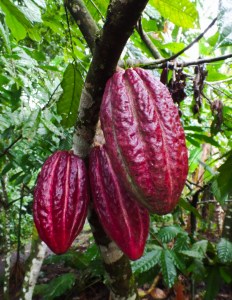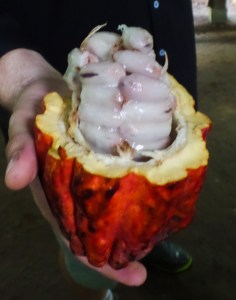A dietitian tours a cacao farm. Her advice? Eat more chocolate!
By Eileen Stellefson Myers
I recently returned from a wonderful trip to Costa Rica where I enjoyed The Rainforest Chocolate Tour in La Fortuna de Carlos.
As a Registered Dietitian Nutritionist (RDN), I know about the nutritional value of dark chocolate. But this farm tour opened my eyes to something completely new.
Prior to my Costa Rica trip, I had only been to a chocolate factory in the U.S., decades ago. I remember cocoa, fat, and milk pouring into large vats and then mixed to the proper consistency.

The pods.
This tour took us through a cacao farm, full of cacao trees bearing oval fruits or pods about 5-12 inches long containing many seeds known as the cacao beans. I learned that in the world of chocolate making, the tree, pod, and beans are referred to as “cacao” and the bean post-roasting is referred to as cocoa.
Cacao pods are ripe when they are a vibrant yellow, orange, or purple color. They hang from the trunk and the largest branches of the tree, very different from where we find apple, orange, and peaches on trees. On the tour, the guide split open a cacao pod that contained several seeds surrounded by white pulp. I was able to suck on the pulp which had a sour taste, not at all resembling chocolate.
The beans were then cleaned and fermented for five to seven days. After fermenting they were dried. I sampled fermented and then dried cacao beans. They didn’t taste great and I gladly spit them out.

The seeds.
Now that I’ve come home and read more about chocolate making, I understand that many farms export the fermented and dried beans to a chocolate maker. But, on our tour, the process of chocolate making continued. After drying, the shells were separated from the meat of the beans called the “nibs.” I tasted the nibs; they tasted more like chocolate but bitter. The nibs were ground into a paste to form a chocolate liquor and then 30 percent pure cane sugar was added (from the sugar cane plant) followed by more rolling, kneading, heating, stirring and aeration until the mixture was smooth. Another tasting and now this 70 percent dark chocolate (pure cocoa meat mixed with 30 percent cane sugar) tasted wonderful!
So here was my embarrassing moment. The tour guide explained that white chocolate is not chocolate. White chocolate is made from the cocoa butter, sugar and milk powder — but not cocoa solids. At the point that chocolate liquor is formed, the chocolate liquor can be separated into cocoa solids, which provide the flavor, and cocoa butter, which is the fat. Although white chocolate contains extracted cocoa butter mixed with sugar and other flavors, it lacks the cocoa “cake” that defines real chocolate.

Eileen gets to grind the nibs!
So, what does it mean to buy a “pure” chocolate bar? Ideally, look for dark chocolate made with as few ingredients as possible. The cocoa bean contains 50 percent cocoa butter. If the first ingredient states chocolate liquor or cocoa meat, it already contains the fat. If the first ingredient is cocoa powder, cocoa butter should be the second ingredient. Sugar is necessary to balance the natural bitterness of cocoa, and the percent chocolate on the package is based on the weight of sugar added. Look for sugar (ideally cane sugar) as the second ingredient, or third ingredient after cocoa butter. A 60-70 percent dark chocolate bar seems to be the happy place of losing the cocoa bitterness without losing the rich flavor. Pure chocolate would have no other ingredients except possibly a flavor such as vanilla, almond or sea salt.
I’ll end this story by summarizing what I always knew about the benefits of this wholesome chocolate. Each ounce of chocolate contains about 160 calories, 3 grams of fiber, and 2 grams of protein. It contains minerals such as magnesium, copper, iron and manganese. It contains both monounsaturated and saturated fats. Chocolate is rich in flavonoids, known for cardiovascular benefits and contains phenylethylamine, theobromine, tryptophan, and anandamide, all thought to be helpful with mood.
This chocolate from the farm I visited fits into the category of natural, wholesome, and organic, perfect for including (in moderation as with everything else) as a regular part of our diet. As long as you are not allergic or have been told to avoid, eat this wholesome chocolate! Spread the word.
_____________________________________
Eileen Stellefson Myers is currently a nutrition and healthcare consultant to business  and industry. Throughout her over 30 years in the nutrition profession, she has specialized in weight management, sports nutrition and eating disorders. She is a certified eating disorder registered dietitian and has received numerous excellence in practice awards. She has authored three editions of her book, “Winning the War Within: Nutrition Therapy for Clients with Eating Disorders” a teaching manual for clinicians working in the field of eating disorders.
and industry. Throughout her over 30 years in the nutrition profession, she has specialized in weight management, sports nutrition and eating disorders. She is a certified eating disorder registered dietitian and has received numerous excellence in practice awards. She has authored three editions of her book, “Winning the War Within: Nutrition Therapy for Clients with Eating Disorders” a teaching manual for clinicians working in the field of eating disorders.





















